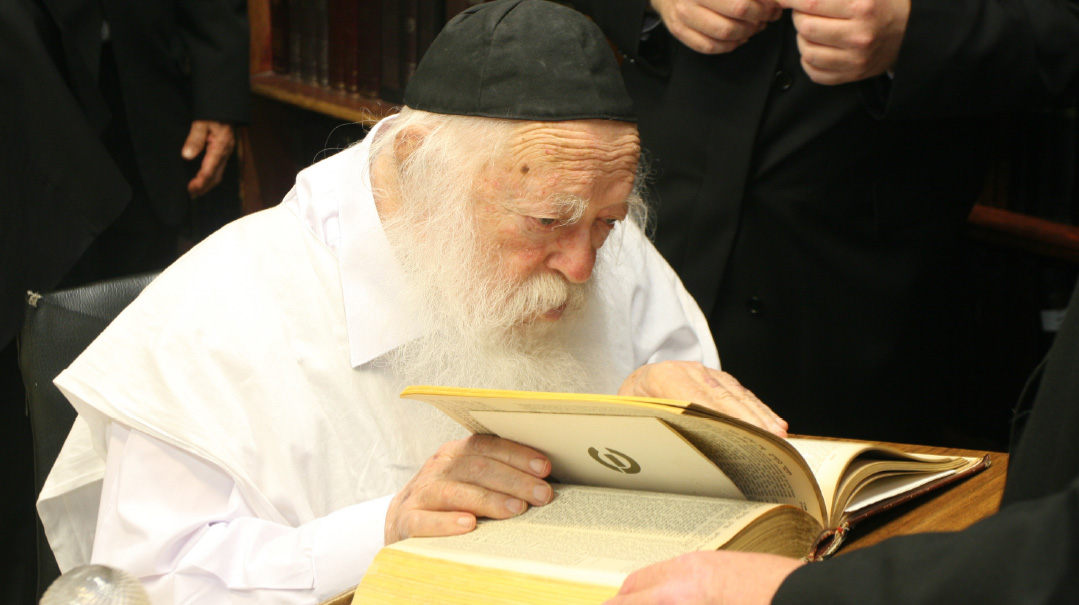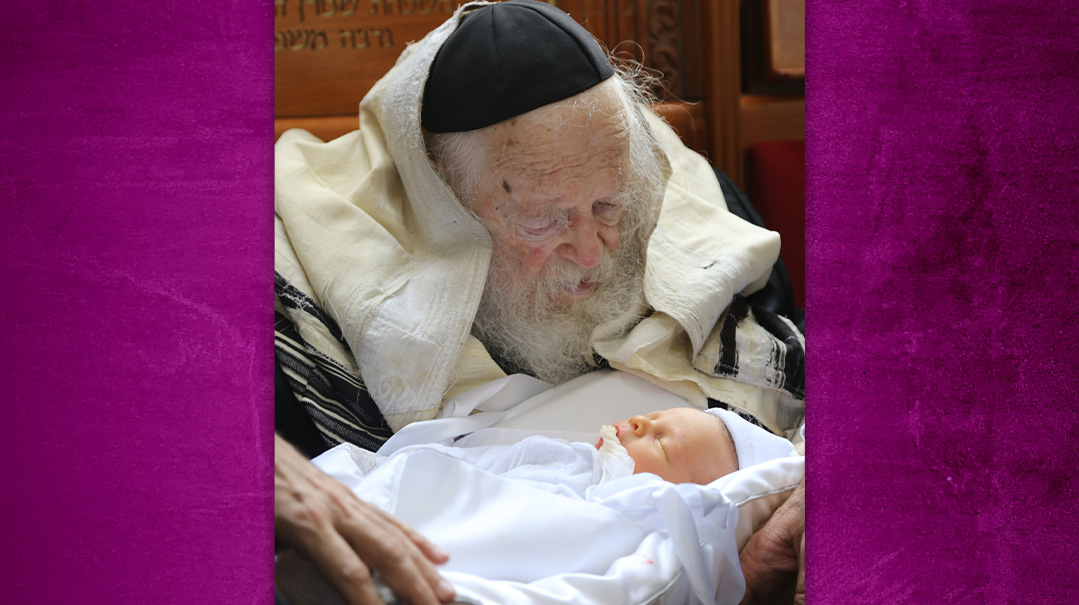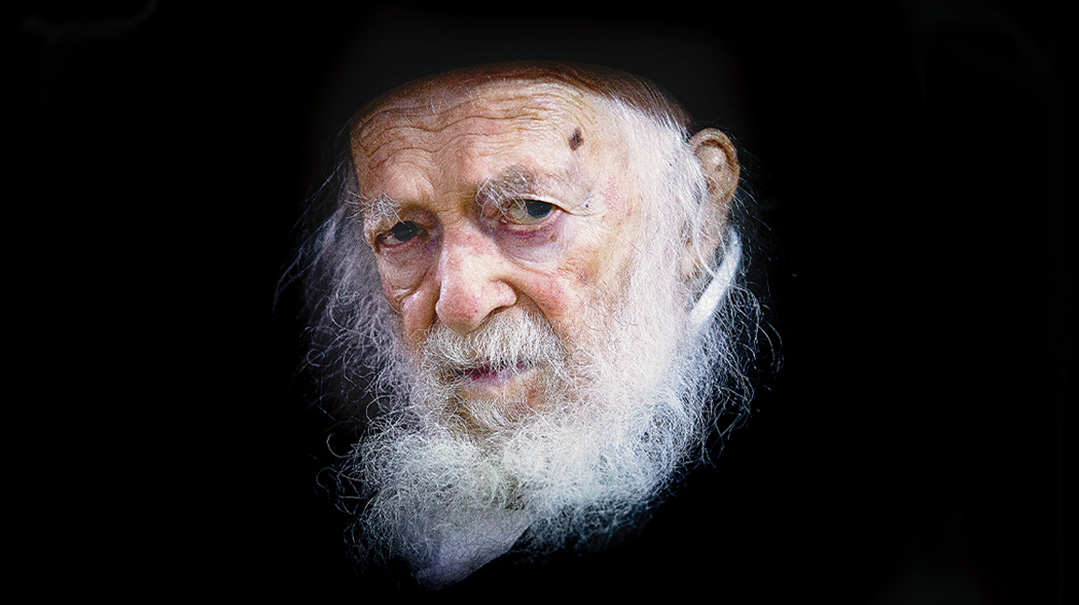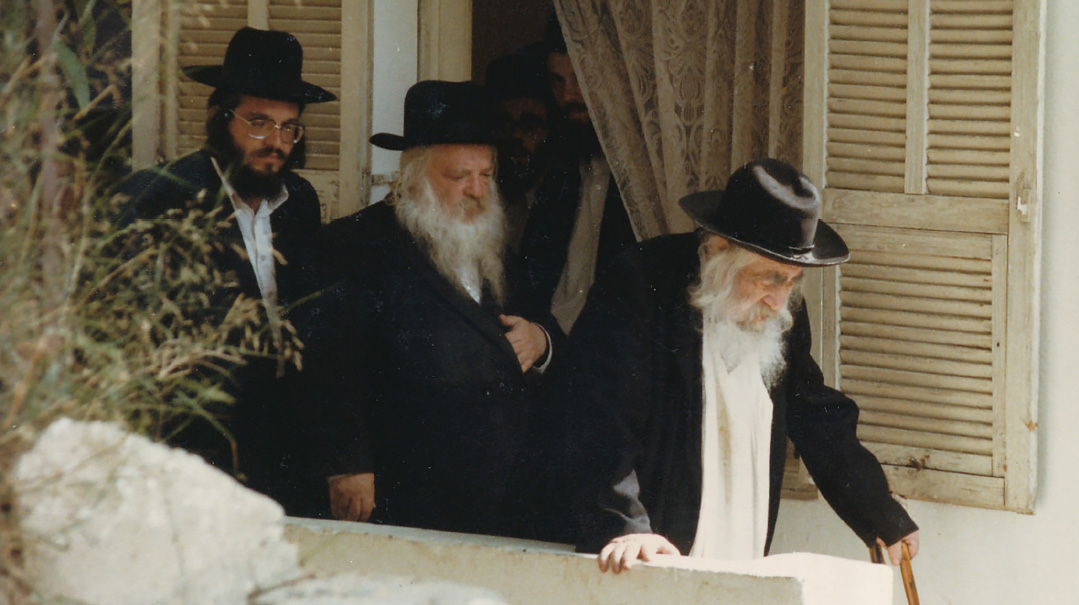A Prince Among Us

We, our family, our nation, were so blessed, for so long, because we, too, had our Rav Chaim
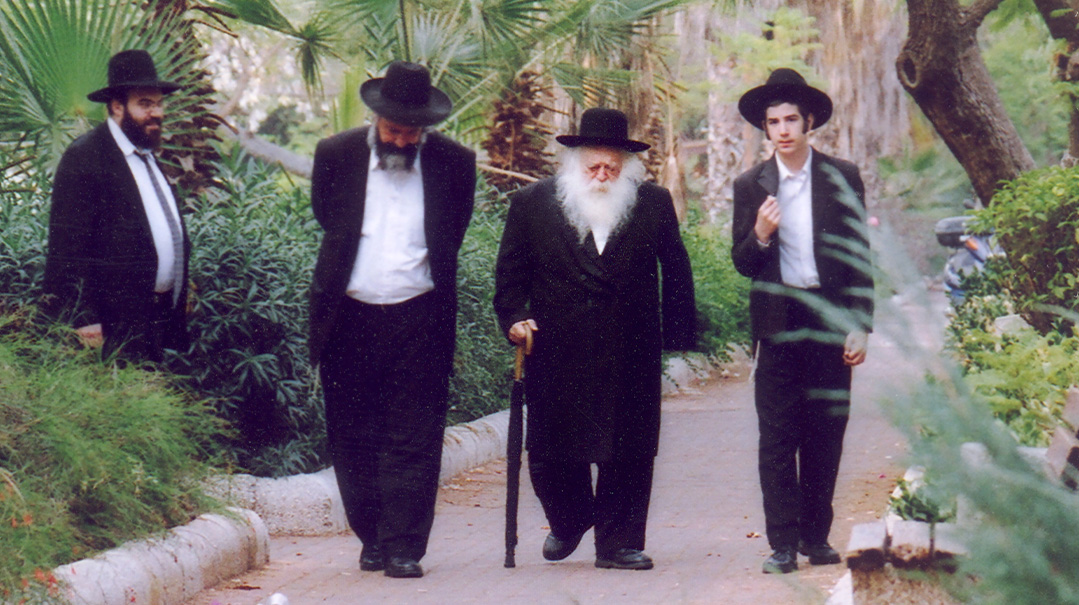
The Steipler Gaon, Rav Yaakov Yisrael Kanievsky, often served as sandek, an honor that is associated with becoming wealthy. Someone pointed out that he did not discern any evidence of such wealth in the Steipler’s home, and wondered aloud what happened to that assurance.
The Steipler answered with two words.
“Mein Chaim’l.”
He was wealthy, because he had his Chaim’l.
And we, our family, our nation, were so blessed, for so long, because we too had our Rav Chaim.
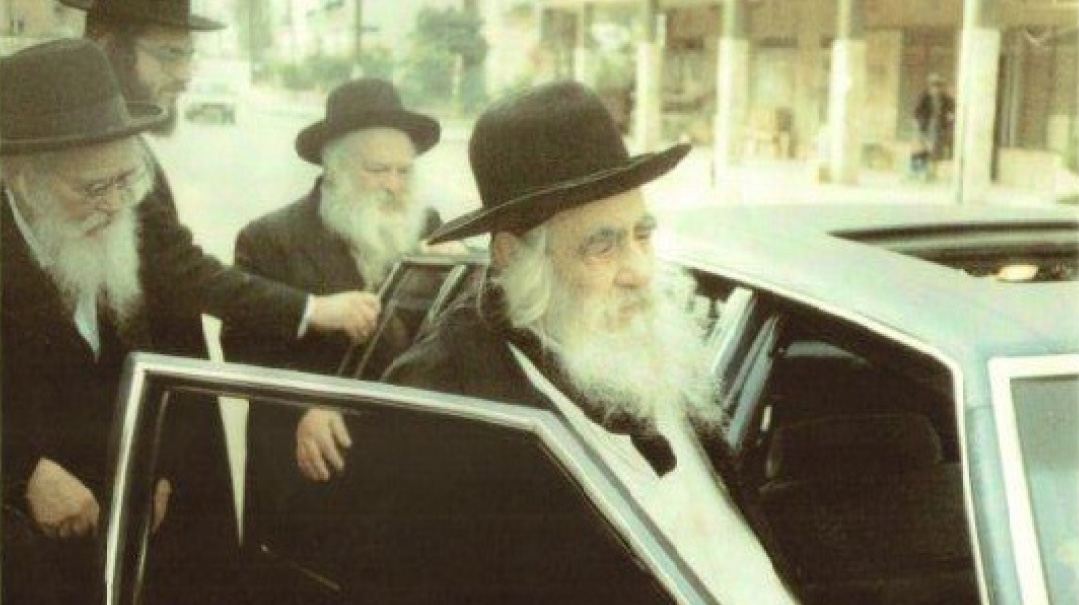
The Steipler knew his gifted young son was cut out for greatness. When offers for positions were presented, the Steipler was strict about his instructions: “You sit and learn”
All of Shas
On the 15th of Teves 5688, Shmaryahu Yosef Chaim Kanievsky was born in the Polish town of Pinsk. He was named for both of his grandfathers, Rav Shmaryahu Yosef Karelitz and Rav Chaim Peretz Kanievsky. Within a few years, the family emigrated to Eretz Yisrael. Their home was a hut at the edge of the fields of Bnei Brak, unimpressive in appearance, but immense in relevance to the Torah world. His mother, Rebbetzin Miriam, was the sister of the Chazon Ish, and they shared a home: The Chazon Ish had no children of his own, and this boy would be raised under his careful, loving watch.
There was a niggun Rav Chaim would teach his children, the one with which his own father put him to sleep each night. The lyrics consisted of the names of the masechtos of Shas. Two-year-old Chaim would jump on the bed singing, “Berachos, Shabbos…” He would end the song in a single breath, “Tevul Yom, Yadayim, Uktzim gib mir a tzuker’l (now give me my candy)….”
The Steipler delighted in the gifted young boy, but in later years, Rav Chaim’s son would reflect on the fact that it could not have been easy — the Chazon Ish and the Steipler had a very different approach to learning than Rav Chaim. Rav Chaim forged his own path, mastering the depth and breadth of every single topic he encountered, but it was not the style of learning of the bochurim who filled the home, speaking in learning with the Chazon Ish.
It took a certain fortitude, but he flourished, learning in the local Talmud Torah of Bnei Brak and spending many hours learning privately with his father. He continued in Tiferes Tziyon yeshivah ketanah, learning under Rav Michel Yehuda Lefkowitz, and after learning under his father in Beis Yosef Novardok for a year, he went to learn in the Lomza Yeshivah in Petach Tikvah. In 1951 he married Batsheva Elyashiv, daughter of Rav Yosef Shalom Elyashiv. The shidduch was arranged by the Chazon Ish.
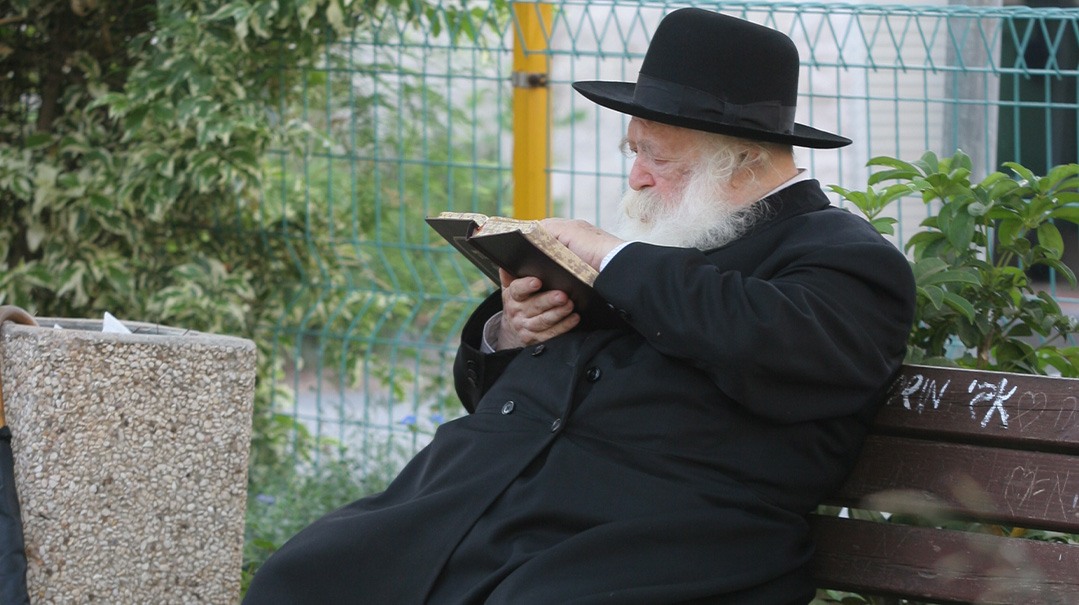
Your Job Is to Learn
The young couple, Rav Chaim and Rebbetzin Batsheva, started their married life in Petach Tikvah, but they soon moved to Bnei Brak, where Rav Chaim joined Kollel Chazon Ish.
This would become his identity, a kollel yungerman completely and totally immersed in his learning. He would daven vasikin each morning and then head off to kollel. He would return home for lunch, which the Rebbetzin had ready and waiting for him, but he would not eat until she was ready to join him. If she was busy, he would stand by the shtender, learning for a minute or two until his wife sat down across from him and they had lunch together.
He enjoyed their time together, but the food didn’t mean much to him — it was simply a means of nourishment. He always knew which brachah rishonah to make, because he saw the food in front of him, but after eating, he often asked which brachah acharonah to make, because he’d forgotten what he’d eaten.
Once a month, he received a stipend from the kollel, which he would give to Rebbetzin Batsheva. She would return the maaser to him to distribute to tzedakah, then use the remainder to cover expenses for their family.
If he ever asked her for money, it was to purchase seforim, and she did her best to try to put away a bit each month to allow him to indulge this love.
He would return to kollel in the afternoon and night, ending his day with Tikkun Chatzos. It was a life saturated with limud haTorah.
Rav Chaim invested time in learning with his children, of course, teaching them the song familiar to him from his youth, testing and reviewing their learning with them regularly. He created charts and graphs to help them with the complex sugyos in Maseches Yevamos and used visual aids when teaching them Maseches Kinnim.
Like the Steipler, he told stories, cherishing the tales of tzaddikim he’d received from his father. He would share stories from the Midrash, the children clamoring for more, feeling the drama in each story from the way he told it.
When the Kanievsky children were young, the family played a special game on Leil Shabbos. They did not use electricity on Shabbos, and they had no generator at the time, just a single kerosene lamp. Once the light went out, they all crowded into the study. One of the children would name a sefer and Rav Chaim would immediately point to its precise location among the thousands of seforim lining the walls, thrilling the young children.
As time passed, people wondered when the young gaon would assume a position as a marbitz Torah, like his father before him.
The offers were many, but the Steipler had given his son strict instructions. “You sit and learn.”
While Rav Chaim kept learning, the Steipler sent his son down a different path of harbatzas Torah.
A respected American Jew heard that the Oxford University library had a microfilm of the peirush of the Rokeach, Rav Eliezer of Worms, about whom the Chida writes that he had a mesorah in gematrios directly from the Anshei Knesses Hagedolah.
This Jew retained the services of a team of scholars experienced in working with kisvei yad and they got to work annotating and reviewing the manuscript. When they were done, the sponsor asked the Steipler how to address discrepancies between the new manuscript and older versions of the Rokeach in print.
The Steipler suggested that a comprehensive review was needed to confirm that the manuscript was indeed written by the Rokeach, and that the work should be done by someone with the expertise to know if the chiddushim it contained corresponded to those in the older texts. In addition, the candidate would have to be capable of locating sources — often in little-known Midrashim — hinted at by the gematrios.
“But who is that talmid chacham who can do that?” asked the sponsor.
“My son, Reb Chaim,” came the reply.
I heard this directly from the American businessman who funded that work. He said that he walked around the neighborhood asking people where Rav Chaim Kanievsky lived, but most people were not even familiar with the name. He eventually located the young talmid chacham in Kollel Chazon Ish — a humble, unassuming person in a faded frock and dusty hat who didn’t seem very interested in the job.
But when he heard his father had recommended him, Rav Chaim agreed, and he did extraordinary work, able to authenticate, verify, and edit the new edition.
“His mastery over every single source was incredible, but equally amazing was how impeccable he was with money,” the sponsor recalled. “He didn’t want to accept payment right away, because he didn’t need the money.”
The American put the money in an account. Several years later, when Rav Chaim was marrying off his daughter, he was ready to accept the funds. But there was a problem: the money had accrued interest, which Rav Chaim said did not belong to him. The sponsor insisted that it did, because he had put that money away specifically for Rav Chaim.
Rav Chaim said he would do another project, working on the peirush of the Rokeach on the haftaros, and this way, he would be comfortable taking the extra money as well.
“It was many years ago,” the sponsor told me, “but I remember the calming feeling of seeing that this path, the Chazon Ish’s fusion of fluency in Torah and also precision in dealing with others, was alive and well.”
Rav Chaim had one other interest outside of learning: He was a shadchan. He saw it as an obligation to help people. But he had no telephone — he invested his precious personal time in visiting both sides, suggesting, encouraging, and guiding, and established many homes this way.
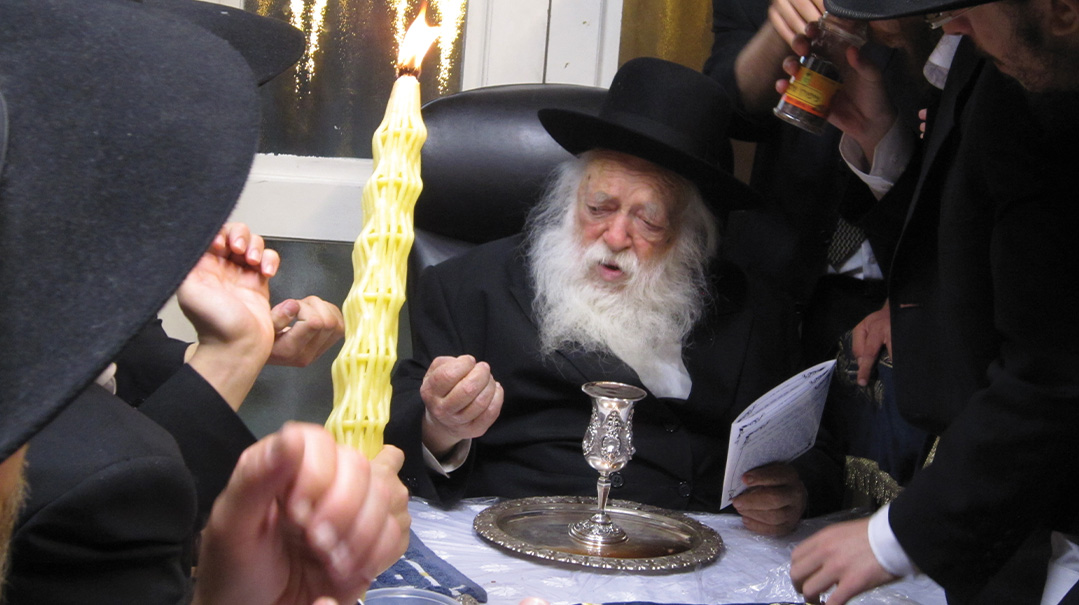
To Say Gut Shabbos
Rav Chaim’s son, Rav Avraham Yeshaya, approached his grandfather to ask whether or not he should undergo a serious operation recommended by his doctors. The Steipler said he could not answer, and in the ensuing weeks, the young man began to lose his eyesight.
He persisted in asking the Steipler how to proceed, and finally, the Steipler said, “I cannot answer — ask your father!”
“My father? What does he know about operations?” asked the grandson.
“When a person sits and learns Hashem’s Torah to the point of being completely immersed in it, then his answers do not come from him, but from the Torah itself, with which he is saturated,” said the Steipler. “I am old and tired, so my immersion in learning is not what it should be, but your father lives in the Gemara. Ask him, and that will be like ruach hakodesh.”
The young man went to his father, explaining that the Zeide had sent him. Rav Chaim contemplated the question for a moment and said, “You should have the operation.”
When Rav Avraham Yeshaya shared this with the Steipler, the gadol reacted with unusual joy, his face aglow as he said, “Baruch Hashem, there is daas Torah.”
Rav Chaim and his father would learn together often, maintaining a seder in Midrash every Shabbos. They learned on the last Shabbos of the Steipler’s life as well, discussing the words of the Midrash that states, “The passing of tzaddikim is as difficult as the burning of the Beis Hamikdash.” A few days later, the Steipler was niftar.
The yungerman from Kollel Chazon Ish understood that his role would shift.
Rav Chaim once told his son Rav Shlomo about the week after the Chazon Ish was niftar, how the regular attendees at the minyan in the Chazon Ish’s home were bereft. Leil Shabbos, after davening, they lined up as usual, but since the Chazon Ish was no longer there, they filed by the Steipler to say “Gut Shabbos.”
“My father was upset, feeling unworthy, but it was clear that Yidden just need someone to say ‘Gut Shabbos’ to, it gives them a good feeling.”
Rav Chaim was ready to be the one people said “Gut Shabbos” to.
To Understand People
Others had considered him an introvert, but those closest to him — his sons, who were also his talmidim and chavrusas — saw a different side to him.
Rav Shlomo Kanievsky told me that his father would frequently take walks with the boys, speaking to them in learning. Along the way, people stopped Rav Chaim to ask questions and speak in learning. Rav Chaim reacted differently to different people, once commenting to his son that there are various types of people. Some want your agreement, while others hope for an argument. Some genuinely want clarity and some people just enjoy speaking in learning. Rav Chaim went on to list five different categories of people, then said, “You have to learn to understand people.”
He understood Torah and he understood people, but there was one area in which he had no expertise at all.
The Gemara appends the title “benan shel kedoshim — a son of holy ones,” to a person who has never beheld the image of a coin.
Money was not unimportant to Rav Chaim — it had no value at all.
A leading American rosh yeshivah recalled sharing a tender with Rav Chaim back to Bnei Brak after an event many decades ago. When they reached Rechov Rashbam, they had to pay the driver, and the others in the car started looking through their pockets for money. Rav Chaim turned to the rosh yeshivah and asked what he was looking for so frantically.
“Shekalim,” he replied, and Rav Chaim said he would go get from his house.
He ascended the steps and came back a minute later, his hand outstretched, and handed the rosh yeshivah a Mishnayos, Maseches Shekalim!
Many years ago, a young talmid chacham from Bnei Brak passed away suddenly, and Rav Chaim was very involved in trying to raise funds for the family. An American philanthropist was drafted to the cause, and he raised a quarter of a million dollars for the family, a huge amount at the time.
When he came to Bnei Brak, he was brought in to Rav Chaim. He expected effusive thanks for his generosity and dedication.
Rav Chaim looked at him for a moment and asked, “When do you have time to learn?”
That was the only real question and the only real message he had.
Until his final days, the millionaires and billionaires who filed through his study received no adulation or special reverence. Hachzakas haTorah was nice and necessary, but limud haTorah is life itself.
Subservient to Rav Chaim
It started after the passing of his father, and it grew from moment to moment.
The “Rogatchover of his generation,” as the Chazon Ish called him, author of landmark seforim and commentaries on the most obscure and complex sections of the Torah, took on the dimension of a father to his nation, perceiving the need of the tzibbur and adapting.
It started even before he uttered the words of blessing. The moment you got a glimpse of him, when you beheld his face through the doorway as you waited to approach, you had this clear sense that you were seeing the glow of the Shechinah, that the radiance of his face came from being one with the Torah.
Rav Chaim’s face was eidus, testimony; Eidus hi l’ba’ei olam, it is a testimony for mankind that the Divine Presence dwells with Yisrael.
He was the light kindling all others. The greatest talmidei chachamim in the nation were desperate for his Torah and clarity, and his precision and reservoirs of knowledge were given to them, the people trying to navigate their way through Zera’im or Eglah Arufah or a complex Rambam.
But not just the talmid chacham.
After the petirah of the Steipler, Rav Chaim started to deliver a shiur in Talmud Yerushalmi. It was a sophisticated, high-level shiur given to accomplished scholars, and it lasted all through the year of mourning. Then Rav Chaim ended it.
His son wondered why, and Rav Chaim explained that he didn’t have the time to invest in preparing the shiur.
How much time did it take? asked the son.
Five minutes, said the father.
Five minutes!
But the same Rav Chaim would answer every single letter that came to his home, investing well more than five minutes in the process.
He explained that to those who wrote earnest letters, seeking help in a sugya, he had an achrayus to answer. And those who didn’t really understand learning, and were sending letters simply to receive his answer? To them, he also had a responsibility, for perhaps the chizuk would uplift them, and they would learn better, with more desire.
In the last few decades of his life, the man who could not spare five minutes to prepare a shiur gave hours to the people, essentially opening his home to the public and showering the people with blessing.
When you went in, it was almost hard to reconcile the actual dimensions of the room with the pictures and videos, for, like the holiest places in our history, the perception and actuality didn’t seem to align.
And even more extraordinary were the brachos themselves, the few words that had the potential to alter the course of a life, to brighten or cleanse or heal, offered so quickly, without any great ceremony.
A young woman was involved in a shidduch with a candidate who seemed right for her. The families liked the idea, and she liked the idea — but she didn’t like the young man. He was pleasant and smart, but there was something about him she found off-putting.
She discussed her misgivings with Rav Avraham Genachovski, who suggested she ask a brachah of Rav Chaim Kanievsky for the shidduch. She was confused, because how could she ask a brachah to get married to someone she didn’t know that she wanted to marry?
He explained that Rav Chaim’s koach in Heaven was different than others. “If he wishes you well, then included in that brachah is the assurance that the circumstances themselves will change, and you will find him endearing. The natural world is subservient to Rav Chaim, and his brachos take everything into account.”
On Sunday of this week, a New York rav told me about his shul, a relatively small kehillah of fewer than a hundred families, and his words hinted at the magnitude of the loss.
“We’re just a regular shul, not Chazon Ish’niks, not a kollel minyan, just simple Yidden. And I was looking around shul on Shabbos counting off the stories in which the kedushah, the tefillah, the koach haTorah of Rav Chaim impacted people in a very real way — the operation he said wasn’t necessary, the unborn child he promised would be fine against the doctor’s prediction, the shidduch that happened within three months of the father undertaking a certain kabbalah, the tremendous chizuk to learn Maseches Sheviis that led to so much brachah in parnassah…. I don’t know where we go from here. We relied on him for his Torah, for his avodah, and for his gemilus chasadim. All three pillars of the world are shaky now.”
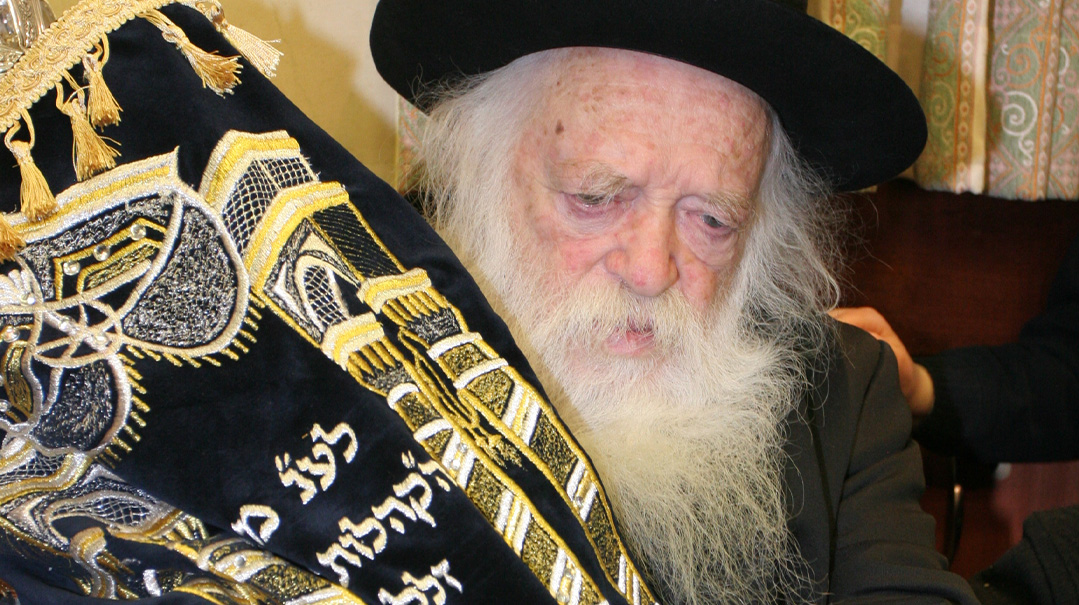
Photo: Family Archives
Like a Rebbe
Rav Chaim captured the hearts of the people like no other, the chein and appeal of Torah itself flowing out of that room. The sight of his black sweater brought joy. A video of the repurposed wedding invitation he used as a placeholder moving slowly down the page of the Gemara was enough to uplift the soul.
His laughter — and there was so much laughter, the man who existed on top of the mountain connected to the people around it — could brighten your day.
He enjoyed a joke. A zealous American bochur leaned in one Shabbos morning after vasikin to ask if it was permitted to say the Yiddish word for “yes,” which is exactly the same word as one of the names of Hashem, the letters “yud” and “hei.”
Rav Chaim looked up and met the gaze of his questioner, his eyes twinkling. “Yoh,” he answered in Yiddish.
The man who belonged to the Torah and to his people belonged not to any one demographic or sector.
A kiruv activist came in to bemoan the fact that, whereas it had once been relatively simple to appeal to secular Jews, it had become increasingly difficult to create full baalei teshuvah in recent years. Yes, Rav Chaim agreed, the Sitra Achra (Force of the Other Side) had gotten in the way of kiruv and was making it very hard.
“Saba is talking like a rebbe,” one of Rav Chaim’s grandchildren joked.
Rav Chaim turned serious. “My father said that whatever little bit of yiras Shamayim he had came because he learned the chassidish sefer Meor Einayim, so I can talk this way….”
An American bochur came to the house on Rechov Rashbam during the years when it was relatively easy to walk in. The Rebbetzin asked him to wait at the door, since her husband had just put his head down for a few minutes.
The bochur explained that he just wanted to recite the brachah one says when seeing a gadol baTorah, but then wondered aloud if it is permitted to say the brachah on a sleeping talmid chacham.
The Rebbetzin paskened. “My husband learns when he is asleep too,” she said. “He is learning right now.”

The Torah Itself
The hesped on Rav Chaim really consists of two words.
Rav Chaim! Rav Chaim!
He filled a role unprecedented in Klal Yisrael and leaves a vacuum equally immense.
If we are to find a glimmer of nechamah, it is in this: We did not find out about him when it was too late, only learning about this prince once he’d been taken.
We cherished him and revered him, Yidden reveling in the chance to imbibe some of that sacred air around him, his radiant face gracing their homes and Succos and hearts.
And in him, we saw a bit of what Torah itself is. The pasuk tells us that “I have counsel and sound wisdom; I am understanding; I have might,” and we saw that a Jew who engraved its words onto his soul embodied that. We saw its sweetness and light in his smile, its healing and blessing in his words. When he told someone who suffered from a leg illness to learn the perek Keitzad Haregel (which literally means foot), or someone worried about hair loss to learn Nega’im, which deals with halachos pertaining to hair, it was not odd, chas v’shalom, but just right. It was the strength of one who’d broken through all barriers to become one with Torah, seeing the true reality and drawing forth its blessings to the world we see as real, but is really make-believe.
And if there is a word that encapsulates the legacy, it might be this one.
Chovos. Obligations.
Yes, the child of greatness, and yes, the brilliant mind, and yes, the extraordinary memory, but the work! The toil! The commitment and unrelenting dedication!
The beloved Novardoker maggid, Rav Yankel Galinsky, once joked that he was greater than Rav Chaim. He explained his reasoning to Rav Chaim.
“Last year, the Rav made his Erev Pesach siyum on kol haTorah kulah and I was there. I wished him that he should merit finishing it again, and he wished me the same. And look whose brachah was fulfilled! Mine came true, while the Rav’s remains unrealized.”
Rav Chaim appreciated the joke and smiled broadly.
“But you know, Reb Yankel,” he quipped, “you don’t become a talmid chacham from brachos. You become a talmid chacham from working.”
So the daily regimen — Zohar, Tehillim, Nach, Mishnah Berurah, Rambam, Tur/Shulchan Aruch, Bavli, Yerushalmi, Tosefta, Midrash, Kisvei Ari, and Ramchal — was not a favor he was doing for the Creator, but an obligation he was fulfilling.
Not tovos for Him, but chovos to Him.
During the week following the marriage of his son, Rav Chaim apologized to the mechutan and excused himself from the sheva brachos that evening. He explained that he could not come because he had chovos.
The new mechutan was uncomfortable, and quickly offered to arrange for a loan.
“No, not financial chovos, baruch Hashem, just we had a chasunah, a busy week, and I have chovos to the Gemara, to the Rambam, the Shulchan Aruch….”
The mechutan, Rav Meir Honigsberg, exclaimed in awe, “One who has such chovos does not have the other type of chovos.”
Rav Chaim lived in a realm inhabited by angels, with no connection to money, honor, or comfort, yet he serviced a world of people like us.
People like us.
People who warmed to his gaze, who looked to him as a flower to sun, who waited for “Rav Chaim to say” before deciding, who thrilled at the knowledge that he was in the world.
We’ve lost so much.
Towers have fallen, and mountains have crumbled, and the world is upside down, but through it all, we knew that Rav Chaim was still here, so we were okay. We were protected. We were his and he was ours.
But what now?
I am rich, said the Steipler, because I have my Chaim’l.
We were rich, too; so fortunate, the treasures of Har Sinai available to us at the top of a steep staircase on Rechov Rashbam. But now we have become poor.
What now? What now?
(Originally featured in Mishpacha, Issue 904)
Oops! We could not locate your form.
